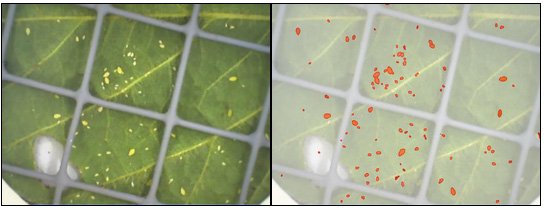An Eye for Aphids
Posted June 2006

Soybeans are a key livestock feed in the US, an important human food source in many parts of the world, and--in the form of biodiesel fuel--a promising source of renewable energy. Informed pest management increases yield and reduces pesticide application: farmers use population estimates obtained by counting the aphids on sample soybean leaves in planning their crop dusting schedules.
However, manual aphid counts are very slow and this low tech problem presents formidable challenges to even the most sophisticated automatic image segmentation methods: the colors of aphids change as the leaves age, with the color of the aphids on young leaves nearly matching that of leaf veins; the intricate structure of the veins and the tendency of aphids to cluster near veins further complicate automated image segmentation.
In mid-February 2006, Martin DuSaire of the USDA contacted the IMA asking for help in using new imaging techniques to obtain accurate counts of aphids on soybean leaves. Long-term visitor Chang-Ock Lee (KAIST) and his graduate student Jooyoung Hahn responded to the challenge by optimizing their segmentation algorithm, which utilizes geometric attraction-driven flow and edge regions, for soybean leaf images. The method involves a geometric analysis of eigenspace in a tensor field on a color image as a two-dimensional manifold and a statistical identification of edge-regions; it requires neither interaction with end users nor mid-process parameter manipulations. Within a few weeks, Lee and Hahn were providing highly accurate, efficient aphid counts.